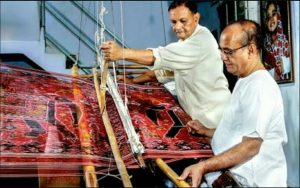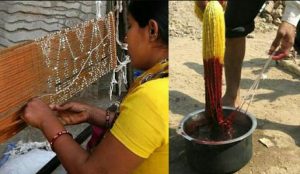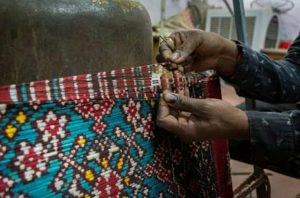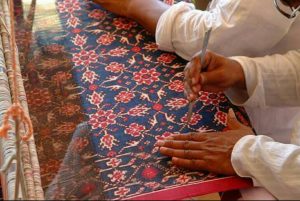Patola is a precious Indian heirloom passed from one generation to other. Patola is among the most high-priced and valuable fabrics. It is not only lionized for its religious significance around various faiths but also for its amazing level of dexterity and assiduity.
The patola weaving is famous for it’s colorful and prominent patterns. It is characterized by tie and dye work. Some of the important designs are Rattan Chowk, in which diamonds cross with diamonds as they are interspersed around walnut, narikunja, dancing girl, parrot, and elephant, chhabri is a basket made up by four elephants, waghkunjar, tiger-elephant. Also, there is a variety of leaf and flower and geometrical patterns. The colors are vivid and pleasantly harmonized.

The Making of Patola
Making of patola is a very time consuming and intricated process. The first step in the production of patola is tying of yarns from cotton thread according to the patterns. The yarns used are normally made from silk (Patan silk).
These yarns undergo many processes of tying and dyeing following a specific color order. Any misplacement of even a single yarn can lead to disturbance in the design of the patola making the entire set of yarn a futile, hence the yarn should be arranged carefully during the whole process.

After the yarns have fully dried, it is stretched for making a wrap. Repairing the threads and arranging the wraps requires a great experience, ergo presence of a master craftsman is entailed.
The patola loom is one of its kind. It is tilted to one side and requires two people to sit and work together on one sari. The rosewood sword-shaped stick called ‘Vi’ is only found in patola look and is used to adjust the yarn.

This whole process requires tremendous accuracy and tenacity. Every color has it’s own significance in the saree and is aligned carefully while weaving. After every few inches weaving The design is adjusted using a steel Needle.
The detailed work of the patola can be observed when watched closely. It takes 6months to a year for the making of one patola saree. But due to the fast life, and lack of time and resources, this wonderful craft is endangered. Only 4 families are striving to save this art.

The Significance of Patola
The original double ikkat sarees are now being replaced by the cheap priced single ikkat saree and also the natural dyes are replaced with synthetic ones. The new patrons who value and appreciate the painstaking effort and time of the master craftsman are the sole hope to preserve the old treasure of craft.
– Darshana Jain

